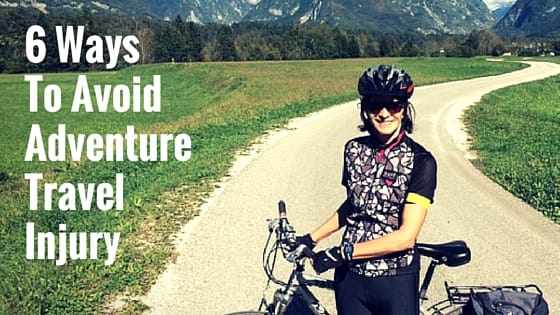
For many of us, Travel isn’t travel without injecting a little adventure in there as well. Pushing your body and mind to it’s limits, while taking in new surroundings and cultures really is the ultimate experience.
Of course to enjoy these adventures, and keep coming back for more, you have to try and keep personal injury at bay. Accidents happen; The slip of a foot on a self guided hiking trail, or a tumble off your bike while attempting a tough corner through Italy’s wine country. However, some injuries can be avoided, so we have compiled a short list of different ways to prevent injury so you can continue to sample the world – living on the edge and enjoying every minute of it.
Take a breather – sit back and enjoy our 6 Ways To Avoid Adventure Travel Injury.
#1 Listen To Your Body
Pain is your body’s way of telling you something’s up. Pushing through pain or ignoring it will only lead to further injury. Deal with injuries early on to help decrease recovery time and prevent a chronic problem from developing. An injury in one part of the body (Eg. The foot) can lead to problems further up the leg (Eg. Knee or hip) if it is not dealt with quickly. If you’ve taken a dive on a trail – don’t brush it off as a “war wound”. Get it looked at so you can get back out there injury free.
#2 Adventure Prep!
Kind of goes without saying that we’re big fans of adventure travel. Of course with adventure travel comes the chance of sustaining injury. To avoid injury, prepare for your trip. Schedule in a training schedule months in advance of your trip that will get you ready for that particular activity. For instance, if you are going to be taking a self guided hiking tour, start your training by walking with the pack you are going to use and gradually increase the distance and weight of the pack. Add hills and valleys to your walks. Get used to the hiking gear you are going to wear. A little prep. can make your next adventure travel experience a fantastic one!
#3 Cool Down/Warm Up
Warm up’s are essential. This can mean a quick walk, jog, or spin on an exercise bike etc. – until you break a sweat. Ideally your warm up activity will involve the muscles you are going to use during your work out. Warm up increases blood flow and oxygen to muscles and increases the ability of the muscles and connective tissue to stretch and prevent injury.
Stretching helps increase the flexibility of muscles so that they won’t tear during an activity. Ideally, stretching should be done after the warm up and cool down periods. Choose stretches that will involve the muscles that are going to be used during your activity. Hear are some general guidelines to follow:
- Do not bounce during stretching
- Hold a stretch for 20-30 seconds
- Do not stretch into pain as you could be damaging the muscle
- Stretch until you feel a comfortable tension in the muscle, which should have lessened by the end of the stretch.
Cool down is done after your activity. It is basically a repeat of the warm up but the purpose is to remove the waste products from your muscles and prevent muscle soreness and stiffness.
#4 Maintain Your Equipment
Running, hiking, or cycling using worn out or incorrect equipment can lead to injury. Cycling with a damaged helmet or downhill skiing with bindings set incorrectly are safety issues that can lead to severe injury.
Proper sizing is just as important as equipment maintenance. Cycling on a bicycle that is too small or the seat is too low, can cause knee problems. Footwear that is too big often leads to blisters and lack of proper foot support. Cross-country ski poles that are too long can cause shoulder injuries.
Equipment can also include any braces being used to prevent re-inquiry of a joint. Make sure it fits properly and the material hasn’t worn out.
#5 Exhaustion
A little exhaustion should be part of your experience while hiking or cycling, it means that you are pushing yourself into new territories and will offer perhaps some of the best sleep you’ll ever experience at the end of the day. But take exhaustion too far out in the wild and you could find yourself in a tough situation. A common cause of exhaustion is dehydration and improper nutrition. Make no mistake about it, when traveling on the trail you are burning a lot of calories and your machine of a body needs a lot of fuel. Bring calorie-dense (and light) food with you on trail, and plan your water sources before you go out; if all else fails, just shorten your intended mileage or take a break and extend the duration of your trip.
#6 Muscle Stress
Nothing is more fun than having your legs cramp with every step you take up the mountain, or that feeling of your toes curling in on themselves as you lay in your tent at night. Cramping is another common hiking & cycling injury that is commonly produced by dehydration. Sounds simple enough then, to avoid cramping make sure you are drinking a lot of water. But sometimes in the heat of the moment, especially if the moment is particularly cold, it can be hard to remember to drink the appropriate amount of H2O. Stretching before your big hike can help, and if you find yourself succumbing to a nasty cramp, stretching further can alleviate some of the pain. Consider applying hot and cold temperatures to the cramp and refueling with an electrolyte-dense sports drink. These solutions can often get you the rest of the way home.
Sources: www.theclymb.com – www.kinsmenphysio.com
